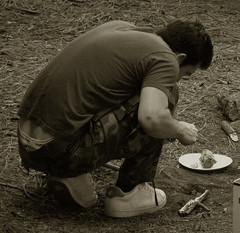 USA TODAY
USA TODAYHe finished his tour and returned home, struggled with headaches and memory loss, went back to Iraq and survived another bombing in February that aggravated his symptoms.
Only after arriving here at the Army's Landstuhl Regional Medical Center with an ankle injury in February did a new and aggressive screening program finally identify Joiner's brain injury and lead to treatment. "I'm just in shock that somebody is figuring out what's wrong with me," says Joiner, 26, who says his gratitude for the treatment outweighs any bitterness over the delay in diagnosing his injury.
The Pentagon debated for years whether to systematically screen troops for brain injuries such as Joiner's. A recent study by RAND Corp., a research group, says such injuries could have affected 320,000 Iraq and Afghanistan war veterans. Uncertain how aggressively to identify a wound that is still largely a mystery, the Pentagon initially resisted calls to screen all service members coming out of the battlefield. Under pressure from Congress, the Pentagon in March ordered all military branches to screen for traumatic brain injury (TBI).
By then, doctors at this key Army hospital — through which all war casualties pass on their way home — already had begun to check each of the wounded for a brain injury in an effort that could set new standards for whether such troops ever return to duty.
This is wonderful news for current troops coming out of combat. Perhaps veterans will be able to avail themselves of this technology also in the future. It certainly will help reduce the stigma of PTSD and brain trauma related injuries. Which in turn will lead to better awareness, which in turn will lead to broader search for effective solutions.
One of which is Emotional Freedom Technique. Some of the things I like about EFT are: you or your soldier can start using it TODAY! it's really inexpensive, it brings quick relief, it is drug free, it is so easy to do. And it can reverse these unseen injuries.
Side effects? Well more energy, more joy, more freedom to live a normal life, more engagement in the present, less depression, less fear, less anger, better sleep-I could go on and on but you get the idea!
thanks for the photo by foreignobsessed
